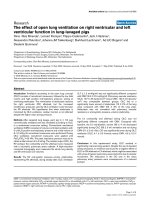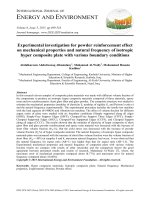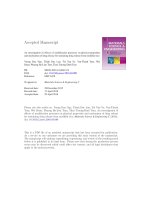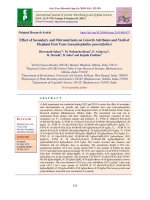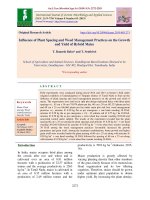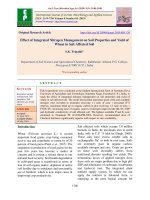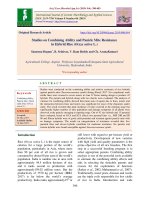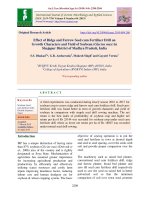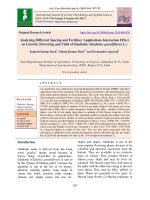Effect of granulated liming material on soil properties and yield of paddy in acid soil of Bramhavara
Bạn đang xem bản rút gọn của tài liệu. Xem và tải ngay bản đầy đủ của tài liệu tại đây (298.3 KB, 10 trang )
Int.J.Curr.Microbiol.App.Sci (2019) 8(4): 1714-1723
International Journal of Current Microbiology and Applied Sciences
ISSN: 2319-7706 Volume 8 Number 04 (2019)
Journal homepage:
Original Research Article
/>
Effect of Granulated Liming Material on Soil Properties and
Yield of Paddy in Acid Soil of Bramhavara
Ganapathi1*, K.S. Niranjana2, S.M. Jayaprakash3 and S. Harshitha1
1
Department of Soil Science and Agricultural Chemistry, College of Agriculture, Navile,
Shivamogga, 2AHRS, Thirthahalli, 3ZAHRS, Brahmavara, University of Agricultural and
Horticultural Sciences, Navile, Shivamogga, India
*Corresponding author:
ABSTRACT
Keywords
Granulated liming
material
paddy, Acid soil,
Bramhavara
Article Info
Accepted:
15 March 2019
Available Online:
10 April 2019
A field experiment was conducted during kharif 2017-18 at ZAHRS,
Bramhavara to study the effect of granulated liming material on soil
properties and yield of paddy. Treatments included lime application as
granulated lime and agricultural lime at different combinations along with
FYM and RDF were studied in this experiment. The results revealed that
the treatment receiving RDF (60:30:60 Kg N, P2O5, K2O/ha) + FYM (10
t/ha) + 50 percent lime requirement through granulated lime based on 45
per-cent Ca saturation (1.14 tonnes/ha) recorded significantly higher
growth parameters, yield, B:C ratio, soil pH, available N, P2O5, K2O and S.
Introduction
Liming materials are commonly applied to
reduce the acidity and to increase productivity
of soils. Correction of soil pH is the
cornerstone of a successful crop nutrient
management program. Soil pH affects
nutrient solubility and influences the sorption
or precipitation of nutrients like Al, Mn, and
Fe. Liming increase the pH of acidic soils and
improves macronutrients availability of soil
while reducing the solubility of Al and Mn.
Pelletized lime is finely ground limestone,
which is made into small pellets for
broadcasting with fertilizer. In pelletized form
the lime is protected from wind drift, and the
uniform texture eliminates any larger,
nonreactive particles that can take years to
fully break down within the soil (Alvarez et
al., 2009). Clay or synthetic binders, such as
lignosulfonates hold the pellets together and
dissolve in contact with rainfall or soil
solution, breaking down by solubilization or
microbial action. The pellets are durable
enough to withstand transport, and minimal
dust is created on spreading. Finer liming
1714
Int.J.Curr.Microbiol.App.Sci (2019) 8(4): 1714-1723
materials dissolve and react more rapidly.
Scott et al., (1992) investigated the most
effective particle size (between 0.005 and 3
mm) of liming material in an acid soil in
Australia and concluded that the finest
limestone particles
produced
greatest
increases of pH, exchangeable Ca and wheat
(Triticum aestivum L.) production. For crop
production, however, soil acidity is a complex
of
numerous
factors
involving
nutrient/element deficiencies and toxicities,
low activity of beneficial microorganisms and
reduced plant root growth that limit nutrient
and water uptake (Fageria and Baligar, 2003).
The situation is further complicated by
various interactions among these factors (Foy,
1992). The practice of correcting soil acidity
reduces the available contents of Al, Fe, Mn,
Zn, and Cu, but increases the availability of
other essential nutrients. Liming is an
effective and dominant practice to raise soil
pH and reduce acidity-related constraints to
improve crop yields (Fageria & Baligar,
2008). The objectives of the present study
was to determine the finely grounded
granulated limestone on chemical properties
in soil and yield of paddy.
Soil samples were collected before and after
treatment imposition and analyzed for soil
chemical properties as per standard
procedure. Growth and yield attributes were
recorded. Soil pH was determined 1:2.5 soil
to water suspension by potentiometric
method (Jackson, 1973). Available nitrogen
in the soil was determined by alkaline
potassium
permanganate
method
as
described by Subbiah and Asija (1956).
Available phosphorus were extracted using
Olsen’s extractant for neutal and alkaline soils
and Bray’s extractant for acid soils and was
determined by spectrophotometer (Jackson,
1973). Available potassium extracted using
neutral normal ammonium acetate was
determined by using flame photometer
(Jackson, 1973). The exchangeable calcium
and magnesium were determined by
Versenate titration method (Jackson, 1973).
Available sulphur was extracted from soil
using 0.15 per cent calcium chloride
solution and determined turbidimetrically as
described by Black (1965). Fertilizer and
manure applied as per package of practices
(POP).RDF: 60:30:60 kg NPK/ha and FYM:
10t/ha.
Materials and Methods
Results and Discussion
The field experiment conducted during kharif
2017-18 at ZAHRS, Bramhavara. The paddy
variety MO4 was selected as test variety. The
soil of the experimental site was having pH
4.86. The available N (191 kg ha-1) and P2O5
(19.9 kg ha-1) content was low while that of
K2O (225.0 kg ha-1) was found medium. The
exchangeable Ca and Mg content were 2.90
and 1.40 cmol (p+) kg-1, respectively and the
available S was15 mg kg-1 (Table 1).
Effect of liming materials on soil chemical
properties and available nutrient status
The testing trial was carried out in RCBD
design with 13 treatments and replicated three
times. Gross plot size of the experiment was
4m2. Liming materials were applied 15 days
before transplanting as per the treatments.
pH
The treatment which received granulated lime
recorded significantly higher soil pH in all the
treatments studied as compared to powdered
agriculture lime applied plots (Table 2).
Granules of liming materials hold longer
duration in the soil to react fully. Granulated
lime holds the soil pH values higher for
longer duration due to higher neutralization
power and reduction of loss in leaching. As
limestone is a source of Ca and Mg and in the
presence of water the carbonates dissolve and
1715
Int.J.Curr.Microbiol.App.Sci (2019) 8(4): 1714-1723
the OH- and HCO3- ions are released, reducing
soil acidity (Havlin et al., 1999).
Available Nitrogen, P2O5 and K2O
Granulated lime applied plots recorded
significantly higher available N, P2O5, K2O
compared to plots receiving powdered
agriculture lime in all the growth stages of
crop. This was due to higher neutralization,
less loss in soil, more reactivity and quality of
granulated lime. Increase in soil pH from
acidic condition by application of liming
material leads to increase in availability of
nutrients. Liming increases the beneficial
microbial activity of the soil with increase in
pH of acidic soil thus enhancing the net
mineralization of organic N which in turn led
to the increase in availability of nitrogen in
soil (Edmeades and Ridley, 2003).
Lime application increased the soil pH which
helped the release of fixed P from the oxides
and hydroxides of Fe and Al thus increased
the P availability in soils (Haynes, 1982)
(Table 3). The ultimate effects of reasonable
application of lime are generally considered
to promote soil K availability as well as the
efficiency of K fertilizer on acid soils
(Pearson, 1958).
Exchangeable Ca and Mg and available
sulphur
The treatments which received granulated
lime recorded significantly higher Ca, Mg and
S compared to plots receiving powdered
agriculture lime in all growth stages of crop.
This was due to higher neutralization, quality
and reactivity of granulated lime. The
liming material
which on
dissolution
released a large amount of Ca & Mg and thus
the available of Ca increased in post harvest
soils. Addition of lime to soil results in
increased Ca availability and, usually, greater
Mg availability as well. This occurs not only
because the direct addition of these elements
increases their relative percentages on the soil
exchange complex, but also because of the
reduced inhibitory effects on plant uptake by
H and A1 (Coleman et al., 1958). Adams and
Pearson (1967) infer from reviewed
experiments showing increased adsorption of
sulfate-S with decreasing pH that liming
probably increases S availability (Table 6–8).
Effect of liming material on growth and
yield of paddy
Among the treatments studied the higher
number of tillers per hill (28.25) and plant
height at harvest (106.11cm) were recorded in
treatment which received RDF(Kg N, P2O5,
K2O/ha)+ FYM (10t/ha)+ 50 % lime
requirement through granulated lime based on
45% Ca saturation as compared to other
treatments (Table 4 ). The liming treatments
recorded significantly higher yield and related
attributes as compared to without liming
treatments (Table 9).
Table.1 Chemical properties of granulated and powdered liming materials used in experiment
Sl. No.
1
2
3
4
5
6
7
Properties
Size
Ca (%)
CaCO3 (%)
Mg (%)
MgCO3 (%)
CCE (%)
Residue (%)
Granulated lime (CaCO3)
2-3 mm(100mesh)
23.30
58.25
9.20
31.57
89.82
20.0
*CCE: Calcium Carbonate Equivalent
1716
Powdered agricultural lime (CaCO3)
100 mesh
23.0
57.5
8.50
29.14
86.64
40.0
Int.J.Curr.Microbiol.App.Sci (2019) 8(4): 1714-1723
Table.2 Effect of liming material on soil pH
Treatments
15DAP 30 DAP 60 DAP At harvest
T1: RDF + FYM (Control)
4.91
4.96
4.88
5.13
T2:RDF + FYM+ 100 % LR through granulated
5.07
5.11
5.38
5.96
lime based on 45% Ca saturation (2.29
tonnes/ha)
T3 :RDF + FYM + 100% LR through (CaCO3)
4.93
5.19
5.35
5.51
powdered Agri. lime based on 45% Ca
saturation (2.29 tonnes/ha)
T4 :RDF + FYM + 75% LR through Granulated
5.18
5.13
5.28
6.05
lime based on 45% Ca saturation (1.72
tonnes/ha)
T5 :RDF + FYM + 75 % LR through powdered
4.80
4.92
5.19
5.41
Agri. Lime (CaCO3) based on 45% Ca
saturation(1.72 tonnes/ha)
T6 :RDF + FYM + 50 % LR through Granulated
5.18
5.27
5.49
5.94
lime based on 45% Ca saturation
(1.14 tonnes/ha)
T7 :RDF + FYM + 50 % LR through powdered
5.00
5.08
5.47
5.73
Agri.lime (CaCO3) based on 45% Ca
saturation(1.14 tonnes/ha)
T8:RDF + FYM + 100 % LR through powdered
5.10
5.37
5.83
6.11
Agri.lime (CaCO3) based on shoemaker method
(2.8 tonnes/ha)
T9:RDF + FYM + 100 % LR through
5.30
5.46
5.87
6.17
granulated lime based on shoemaker method
(2.8 tonnes/ha)
T10:RDF + FYM + 50 % LR through granulated
5.05
5.08
5.14
5.97
lime
based on shoemaker method(1.4
tonnes/ha)
T11: Powdered Agri. lime (CaCO3) @ 500 kg/ha
4.76
4.96
4.95
5.83
T12: Granulated lime (CaCO3) @ 500 kg/ha
4.98
5.06
5.04
5.18
T13:Granulated lime @250 kg/ha
4.76
4.91
4.95
5.06
SEM +_
0.22
0.25
0.22
0.25
CD@5%
CV (%)
0.63
7.51
*DAP-Days After Planting
1717
0.74
8.57
0.63
7.09
0.74
7.42
Int.J.Curr.Microbiol.App.Sci (2019) 8(4): 1714-1723
Table.3 Effect of liming materials on soil available nitrogen status (Kg ha-1)
Treatments
T1
T2
T3
T4
T5
T6
T7
T8
T9
T10
T11
T12
T13
SEm±
CD@5%
CV(%)
15DAP
192.36
222.36
210.26
241.69
213.28
246.39
236.29
227.29
258.29
241.26
203.65
212.29
209.25
5.63
16.43
8.36
30 DAP
198.27
236.12
218.64
246.29
222.36
269.24
246.29
232.14
260.19
259.24
210.26
221.36
216.29
6.95
20.30
8.16
60 DAP
196.27
242.36
222.36
259.34
238.26
271.26
253.61
241.37
270.19
271.29
219.27
223.54
219.29
6.84
19.95
8.91
At harvest
194.38
249.24
227.29
271.29
243.29
278.19
262.31
249.27
276.19
275.29
221.63
226.19
221.35
7.40
21.61
8.88
Table.4 Effect of liming materials on soil available P2O5 (Kg ha-1)
Treatments
15DAP
30 DAP
60 DAP
At harvest
T1
T2
T3
T4
T5
T6
T7
T8
T9
T10
20.14
24.15
23.25
27.15
25.61
28.15
24.26
26.19
28.16
27.16
21.35
26.19
24.26
28.16
26.14
28.16
25.62
24.19
29.16
27.19
20.16
26.28
26.15
29.14
24.26
29.24
28.43
27.16
31.26
31.26
19.16
32.15
31.26
31.26
29.16
34.26
29.16
28.15
31.94
31.69
T11
T12
T13
SEm±
CD@5%
CV(%)
24.26
21.26
20.31
1.05
3.08
7.37
26.16
23.14
22.14
0.99
2.88
8.10
28.21
24.15
23.14
0.95
2.78
8.19
28.94
26.21
24.38
1.04
3.03
8.15
1718
Int.J.Curr.Microbiol.App.Sci (2019) 8(4): 1714-1723
Table.5 Effect of liming materials on soil available K2O (Kg ha-1)
Treatments
15DAP
30 DAP
60 DAP
At harvest
T1
T2
T3
T4
T5
T6
T7
T8
T9
T10
T11
T12
T13
SEm±
CD@5%
CV(%)
226.34
230.98
228.31
249.21
234.36
261.22
238.16
248.62
246.16
251.23
238.19
236.15
231.26
7.58
22.12
8.47
228.32
228.36
221.25
246.23
238.16
268.24
241.26
249.24
256.31
258.31
248.19
241.26
238.16
6.81
19.87
8.85
241.36
241.36
230.16
256.14
249.26
271.46
243.15
261.26
289.24
259.26
249.321
241.29
239.16
7.64
22.31
9.23
230.21
243.21
238.16
261.26
246.39
279.31
249.34
268.61
292.16
272.16
251.29
250.31
239.29
7.83
22.86
8.25
Table.6 Effect of liming materials on soil exchangeable calcium (cmol(p+)Kg-1)
Treatments
15DAP
30 DAP
60 DAP
At harvest
T1
T2
T3
T4
T5
T6
T7
T8
T9
T10
T11
T12
T13
SEm±
CD@5%
CV(%)
3.1
4.4
4.1
4.3
4.1
4.5
4.1
4.1
4.1
4.3
3.6
3.4
3.1
0.14
0.40
7.08
3.3
4.7
4.3
4.8
4.3
4.6
4.4
4.2
3.8
4.6
3.8
3.6
3.5
0.13
0.37
8.34
3.1
4.9
4.6
4.9
4.3
4.8
4.5
4.6
4.2
4.2
3.4
3.7
3.5
0.13
0.37
9.17
3.2
5.6
4.8
5.1
4.3
4.7
4.7
4.4
4.4
4.4
3.4
3.8
3.6
0.13
0.38
8.18
1719
Int.J.Curr.Microbiol.App.Sci (2019) 8(4): 1714-1723
Table.7 Effect of liming materials on soil exchangeable magnesium (cmol(p+)Kg-1)
Treatments
T1
T2
T3
T4
T5
T6
T7
T8
T9
T10
T11
T12
T13
SEM
CD
CV(%)
15DAP
15.26
21.26
19.24
24.16
23.24
24.23
23.14
25.16
24.36
25.31
18.16
19.26
18.35
0.68
1.99
8.45
30 DAP
18.26
25.36
19.25
25.16
25.16
26.15
25.34
28.31
24.63
25.34
21.36
19.15
18.29
0.85
2.47
8.26
60 DAP
14.25
24.26
21.36
27.36
24.36
25.49
24.16
29.16
28.34
26.38
23.31
21.36
19.26
0.92
2.68
8.64
At harvest
17.60
29.31
24.15
29.34
27.26
28.15
28.25
31.32
29.19
29.92
24.21
24.36
21.31
0.93
2.72
8.02
Table.8 Effect of liming materials on soil available sulphur status (mg Kg-1)
Treatments
T1
T2
T3
T4
T5
T6
T7
T8
T9
T10
T11
T12
T13
SEM
CD
CV(%)
15DAP
15.26
21.26
19.24
24.16
23.24
24.23
23.14
25.16
24.36
25.31
18.16
19.26
18.35
0.68
1.99
8.45
30 DAP
18.26
25.36
19.25
25.16
25.16
26.15
25.34
28.31
24.63
25.34
21.36
19.15
18.29
0.85
2.47
8.26
1720
60 DAP
14.25
24.26
21.36
27.36
24.36
25.49
24.16
29.16
28.34
26.38
23.31
21.36
19.26
0.92
2.68
8.64
At harvest
17.60
29.31
24.15
29.34
27.26
28.15
28.25
31.32
29.19
29.92
24.21
24.36
21.31
0.93
2.72
8.02
Int.J.Curr.Microbiol.App.Sci (2019) 8(4): 1714-1723
Table.9 Effect of liming materials on growth and yield of transplanted paddy
Treatments
Yield (kg ha-1)
Grain
Straw
No.
tillers/hill
T1
T2
T3
T4
T5
T6
T7
T8
T9
T10
T11
T12
T13
SEm+
CD@5%
5766
6900
6600
6966
6533
7400
6600
6400
6821
7009
6666
7016
6033
504.11
1501.16
850
10810
10029
10537
9672
9358
9690
11365
10299
11214
8652
9220
8650
847.13
2474.35
19.00
25.20
21.00
24.50
22.50
28.25
23.50
20.00
23.70
26.20
24.10
27.20
23.3
0.47
1.37
CV (%)
13.29
15.21
14.03
of Plant height Percent increase in
at
harvest yield over control (%)
(cm)
85
102
19.65
93
14.45
102
20.80
95
13.81
106
28.32
98
14.45
93
10.98
90
18.29
102
11.62
98
15.60
104
21.67
97
04.62
1.9
5.62
17.23
Table.10 Economics of granulated liming material in transplanted paddy
Treatments
COC
GR
NR
T1
T2
35,000.00
41,693.30
52,319
67,505.17
B:C
Ratio
17,319.00
1.49
25,811.86
1.62
T3
T4
T5
T6
T7
T8
T9
T10
T11
T12
T13
37,500.00
38,600.00
36,350.00
36,653.00
35,625.00
40,350.00
49,133.00
38,466.60
35,500.00
36,333.30
35,666.66
64,414.67
67,968.67
63,636.33
69,945.73
64,245.00
63,282.67
66,538.50
68,688.00
64,326.00
67,760.34
58,617.00
26,914.67
29,368.67
27,286.33
33,292.73
28,620.00
22,932.67
17,405.50
30,221.40
28,826.00
31,427.04
22951.00
1.72
1.76
1.75
1.90
1.80
1.57
1.35
1.78
1.81
1.86
1.69
*COC: Cost of cultivation GR: Gross return NR: Net return B: C: Benefit cost ratio
Grains @Rs. 900/quintal
Straw @RS: 0.5/kg
1721
Int.J.Curr.Microbiol.App.Sci (2019) 8(4): 1714-1723
Among the different treatments studied
revealed that higher grain (7400kg/ha) and
straw yield (9358kg/ha) was recorded in the
treatment which received RDF + FYM +50%
LR through granulated lime based on 45% Ca
saturation (1.14 tonne/ha) as compared to
remaining treatments. Among the granulated
and powdered agriculture lime there was a
higher yield was recorded in granulated lime
(Table 4). It appears that liming increased soil
pH and availability of nutrients which
increased the yield components of paddy
finally higher yields of paddy. Similarly
liming had positive effects on the yield as
reported by Lalljee and Facknath (2001).
Application of calcium silicate @ 45 per cent
calcium saturation level increased the both
grain (69.75 q ha-1) and stover yield (64.15 q
ha-1) of maize as reported by Shetty et al.,
(2012). The treatment which received RDF +
FYM + 50 % lime requirement through
granulated lime based on 45% Ca saturation
recorded higher gross returns (Rs 69,945.75),
Net returns (Rs 33,292.73) and B: C ratio
(1:90) followed by granulated lime (CaCO3)
@ 500 kg/ha as been recorded gross returns
(Rs 67760.67) net returns (Rs 31427.04) and
B: C (1.86) (Table 10).
In conclusion, liming to soil significantly
increased soil pH, available nutrient status
and crop yield. Granulated liming material
recorded higher level of soil pH, available
nutrient status and crop yield.
References
Alvarez, E., Viade, A. and Fernandez-Marcos,
M.L., 2009, Effect of liming with
different sized limestone on the forms
of aluminum in a Galician soil (NW
Spain). Geoderma, 152: 1–8.
Adams, P. and Pearson, H. W., I967, Crop
response to lime in the southern United
States and Puerto Rico. American Soc of
Agron Monograph, 12: 161-206.
Black, C. A., 1965, Methods soil analysis.
Part II. Agronomy Monograph No. 9.
Am. Soc. Agron. Inc., USA, 9: 891-901.
Edmeades, D.C. and Ridley, A. M., 2003,
Using lime to ameliorate topsoil and
subsoil acidity. In: RENGEL Z., ed.
Handbook of soil acidity. New York,
Marcel Dekker, p.297-336.
Fageria, N.K. and Baligar, V.C., 2003,
Fertility management of tropical acid
soil for sustainable crop production. In:
RENGEL, Z., ed. Handbook of soil
acidity. New York, Marcel Dekker,
p.359-385.
Fageria, N.K. and Baligar, V.C., 2008,
Ameliorating soil acidity of tropical
Oxisols by liming for sustainable crop
production. Adv. Agron., 99:345-431.
Foy, C.D. Soil chemical factors limiting plant
root growth. Adv. Soil Sci., 19:97-149,
1992.
Haynes, R. J., 1982, Effects of liming on
phosphate availability in acid soils.
Plant Soil, 68: 289-308.
Havlin, J., Beaton, J.D., Tisdale, S. L. and
Nelson, W. L., 1999, Soil fertility and
fertilizers; An introduction to nutrient
management. Upper Saddle River,
Prentice Hall, p. 499.
Jackson, M. L., 1973, Soil Chemical
Analysis.
Prentice-Hall
Inc.,
Englewood Cliffs, New Jersy. p. 498.
Pearson, R. W., 1958, Liming and fertilizer
efficiency. Agron J., 50: 356-362.
Lalljee, B. and Facknath, S., 2001, Effect of
lime on nutrient content of soils, yield
and nutrient content of potato and
infestation by leaf miners. Food and
Agricultural Research Council, Réduit,
Mauritius, p. 139-147.
Coleman, N. T., Kamprath, E. J., and Weed,
S. B., 1958, Liming. Advances in
Agronomy, 10: 75-522.
Scott, B.J., Conyers, M. K., Fisher, R. and
Lill, W., 1992, Particle size determines
the efficiency of calcitic limestone in
1722
Int.J.Curr.Microbiol.App.Sci (2019) 8(4): 1714-1723
amending acidic soil. Australian J. Soil
Res., 43: 1175-1185.
Shetty, V. Y., Ravi, M.C. and Ganapathi, 2012,
Effect of deifferent sources and levels of
liming materials on yield of maize and
related changes in soil properties. Green
farming, 3(5):523-526.
Subbiah, B. U. and Asija, G. L., 1956, Rapid
procedure for the estimation of the
available nitrogen in soil. Curr. Sci., 25:
259-260.
How to cite this article:
Ganapathi, K.S. Niranjana, S.M. Jayaprakash and Harshitha, S. 2019. Effect of Granulated
Liming Material on Soil Properties and Yield of Paddy in Acid Soil of Bramhavara.
Int.J.Curr.Microbiol.App.Sci. 8(04): 1714-1723. doi: />
1723
